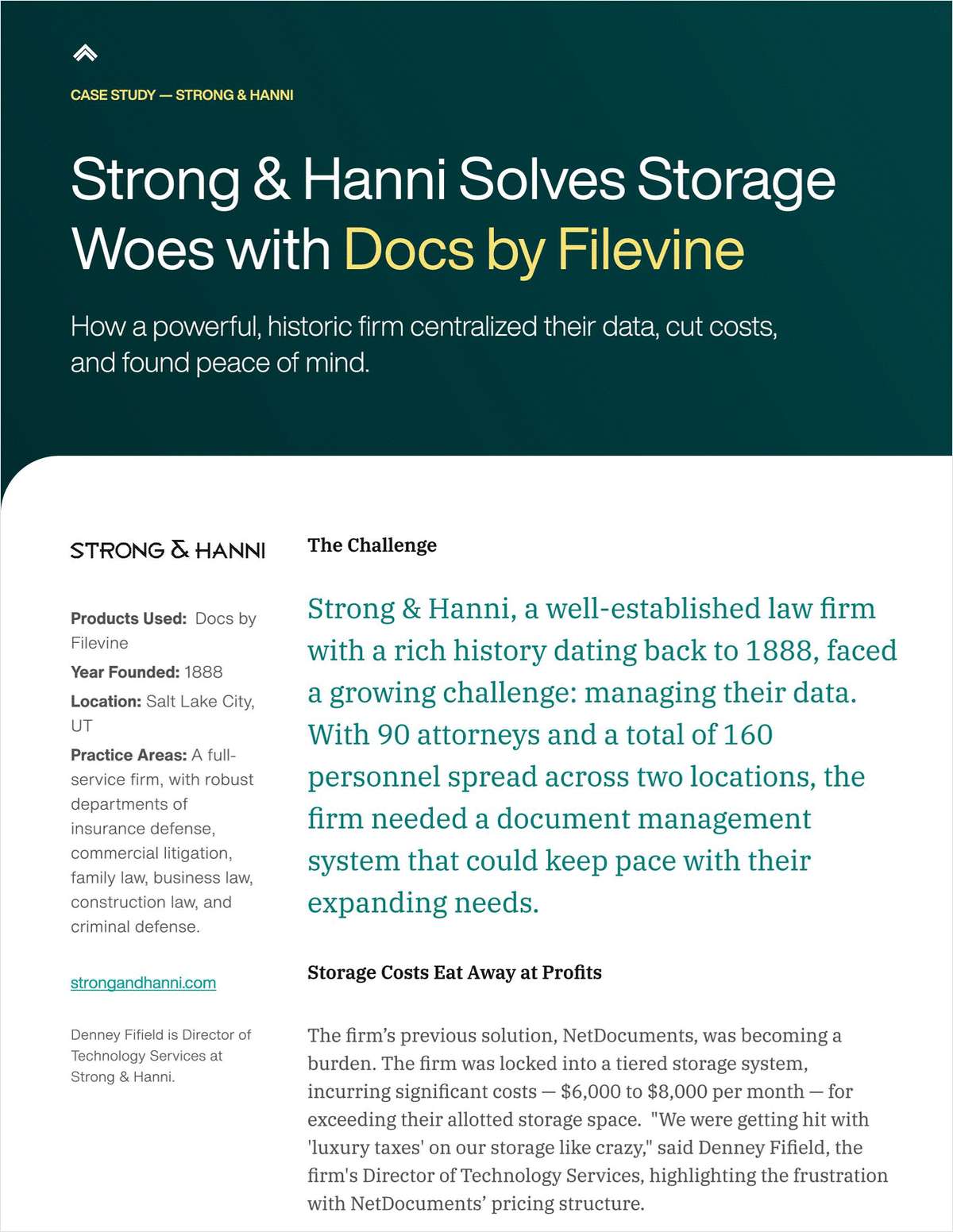'Woman in Gold' Case Puts Art Restitution Claims in Perspective
The feature film 'Woman in Gold' provides an opportunity to explore the some of the complexities of pursuing restitution claims for art looted by the Nazis--and the moral imperative of ensuring that the claims are resolved in victims' favor, writes Nicholas M. O'Donnell.
May 18, 2015 at 03:54 PM
5 minute read
 Nicholas O'Donnell
Nicholas O'Donnell
The feature film 'Woman in Gold,' adapted from a book by Anne Marie O'Connor and starring Helen Mirren and Ryan Reynolds, provides an opportunity to remind ourselves why the case on which it is based was so powerful. The story traces the creation of Gustav Klimt's famous portrait of Adele Bloch-Bauer, its seizure by Nazi authorities after the Austrian Anschluss in 1938, and the international battle that ultimately led to its restitution. Only through courthouse doors could these accounts of Nazi art looting have become known, and these victims finally receive justice seven decades later, rather than being relegated to the dust bin of history like so many others.
 Adele Bloch-Bauer, the wife of Ferdinand Bloch-Bauer, was the subject of the portrait to which the title of the film refers. When Adele died in the 1920s, her will unequivocally left the painting to Ferdinand, and expressed her desire that her husband leave the painting to the Austrian National Gallery upon his death.
Adele Bloch-Bauer, the wife of Ferdinand Bloch-Bauer, was the subject of the portrait to which the title of the film refers. When Adele died in the 1920s, her will unequivocally left the painting to Ferdinand, and expressed her desire that her husband leave the painting to the Austrian National Gallery upon his death.
Ferdinand died before the Second World War ended, having fled from Austria to Switzerland. His will left his property to his nieces and nephews, but his wishes were of little consequences to the Nazis, who had seized his belongings. Far from being able to claim their inheritance, his family was also forced to flee Austria. After the war, the Bloch-Bauer's art was retained in the National Gallery at the Belvedere in Vienna.
In the late 1990s, Bloch-Bauer's niece Maria Altmann, nee Maria Bloch-Bauer, realized that the painting was at the Belvedere, along with several others that had belonged to her family. By then, she had lived in Los Angeles for decades. Her requests for the paintings' return were denied on the grounds that Adele Bloch-Bauer's will dictated that the paintings be left to the National Gallery. This was, of course, not true, and particularly absurd given what the government later did to her husband and their family.
After efforts at mediation or agreement failed, Altmann's remaining option in Austria was to file a lawsuit. To do this, however, she would have been required to post a percentage of the value of the property at issue, which in this case would have been prohibitive for anyone except a billionaire.
Instead, Altmann turned to the U.S. courts. She invoked the “expropriation exception” of the Foreign Sovereign Immunities Act, arguing that since the claim concerned rights in property taken in violation of international law, and since Austria engaged in present-day commercial activity in the United States, Austria was not immune from legal actions in the U.S. Her lawyer was E. Randol Schoenberg of Los Angeles.
The effort was widely considered to be doomed. It was squestionable whether FSIA applied retroactively to events before its passage in 1976. But Altmann and Schoenberg persevered, and in 2004 the U.S. Supreme Court—over the objection of the U.S. Department of Justice—ruled that Austria was not immune and that the case could proceed.
At that point, Austria expressed willingness to arbitrate. This was a huge risk for Altmann and Schoenberg, because an arbitration result cannot usually be appealed. But they relied on the facts, and they won. But they made their factual case: this was an illegal taking that could not be defended or validated, and the arbitrator agreed that ownership never left the Bloch-Bauer family. Accordingly, the rightful owner was Altmann, not the Austrian museum.
'The Woman in Gold' now hangs in the Neue Galerie in New York. Altmann passed away in 2011.
All Nazi-era restitution cases are gripping and highly particular in their details. Altmann's case is unique because it confirmed the jurisdiction of U.S. courts to hear restitution cases, which has been upheld and expanded in the decade since. In so doing, it ended much of the confusion that was in place even after the Washington Conference of 1998, which put the world on notice that hushed denials and deflections of accusations of Nazi art theft would not suffice, that national collections that had treated restitution dismissively now did so at their peril. More than a few museums had put off victims in the way that Maria Altmann was put off. Her victory made it more difficult for museums to treat other claimants dismissively.
The case also has an essential moral dimension, which unfortunately has been too often overlooked in favor of focusing on the monetary value of the paintings. It is essential that the rightness of Altman's case not be forgotten, because focusing on this dimension of her quest helps to properly frame other restitution claims. Frequently, there are malevolent undertones in a great deal of Holocaust art restitution cases that draw a thinly-veiled connection between the claims and Jewish heirs seeking money. Many such comments are sadly repeated even today, as a quick online search will reveal. Emphasizing the ethical obligation of returning the paintings provides a firm refutation to these specious and repugnant claims.
The quest for restitution of art looted by the Nazis is far from over. Coverage of more recent cases about art extorted from Jewish owners has regrettably adopted the sinister tropes discussed above. As other victims pursue justice, it is essential to properly understand their quests in light of Altman and Schoenberg's work as a journey to achieve justice.
Nicholas M. O'Donnell is a partner at Sullivan & Worcester LLP and founder of the blog Art Law Report.
NOT FOR REPRINT
© 2024 ALM Global, LLC, All Rights Reserved. Request academic re-use from www.copyright.com. All other uses, submit a request to [email protected]. For more information visit Asset & Logo Licensing.
You Might Like
View All
Google Fails to Secure Long-Term Stay of Order Requiring It to Open App Store to Rivals

How I Made Partner: 'Build Meaningful Relationships With as Many People as Possible,' Says Joseph Falk of Foley Mansfield

Elder Litigators Confront Tough Questions in Last Act of Careers

Orrick Secures Summary Judgment for RingCentral in Privacy Class Action
Trending Stories
- 1The Law Firm Disrupted: Playing the Talent Game to Win
- 2A&O Shearman Adopts 3-Level Lockstep Pay Model Amid Shift to All-Equity Partnership
- 3Preparing Your Law Firm for 2025: Smart Ways to Embrace AI & Other Technologies
- 4BD Settles Thousands of Bard Hernia Mesh Lawsuits
- 5A RICO Surge Is Underway: Here's How the Allstate Push Might Play Out
Featured Firms
Law Offices of Gary Martin Hays & Associates, P.C.
(470) 294-1674
Law Offices of Mark E. Salomone
(857) 444-6468
Smith & Hassler
(713) 739-1250








